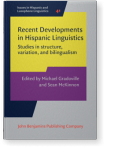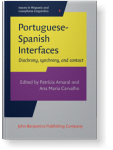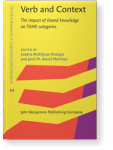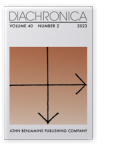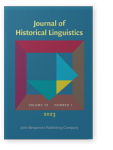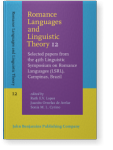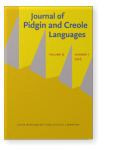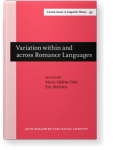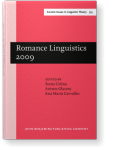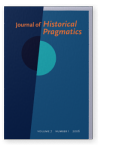Patrícia Amaral
List of John Benjamins publications for which Patrícia Amaral plays a role.
Book series
Title
Portuguese-Spanish Interfaces: Diachrony, synchrony, and contact
Edited by Patrícia Amaral and Ana Maria Carvalho
[Issues in Hispanic and Lusophone Linguistics, 1] 2014. vi, 468 pp.
Subjects Comparative linguistics | Romance linguistics | Theoretical linguistics
2023 Revisiting verbs and plurality Verb and Context: The impact of shared knowledge on TAME categories, Rodríguez Rosique, Susana and Jordi M. Antolí Martínez (eds.), pp. 19–40 | Chapter
This chapter examines a frequentative periphrasis found in Brazilian Portuguese (BP), formed by the verb viver ‘to live’ and a verb in the gerund, and analyzes its aspectual and evaluative properties. Building on data from contemporary BP (Corpus NILC/São Carlos and Twitter), it is proposed that… read more
2023 Tracing semantic change with distributional methods: The contexts of algo Diachronica 40:2, pp. 153–194 | Article
This paper uses the tools of distributional semantics to investigate the semantic change of algo from a noun meaning ‘goods, possessions’ and an indefinite pronoun ‘something’ in the Medieval/Classical period of Spanish to an indefinite pronoun and degree adverb ‘a bit’ in contemporary Spanish.… read more
2023 Tracing semantic change in Portuguese: A distributional approach to adversative connectives Journal of Historical Linguistics 13:1, pp. 1–34 | Article
This study uses word embeddings to investigate the semantic changes underlying the creation of two adversative connectives in Portuguese, porém and mas ‘but, however’. For porém, we chart its development from an original PP formed by a preposition with a causal meaning (por) and a demonstrative… read more
2018 Chapter 2. Subcategorization and change: A diachronic analysis of sin embargo (de que) Contemporary Trends in Hispanic and Lusophone Linguistics: Selected papers from the Hispanic Linguistic Symposium 2015, MacDonald, Jonathan E. (ed.), pp. 31–48 | Chapter
This paper analyzes the syntactic and semantic changes undergone by the PP sin embargo ‘without obstacle/impediment’ as it develops its clause-taking properties in Spanish from the 12th to the 16th centuries, essential for its further reanalysis as a concessive connective. We argue against an… read more
2017 Chapter 1. Modality, presupposition and discourse: The meaning of European Portuguese afinal and Italian alla fine Romance Languages and Linguistic Theory 12: Selected papers from the 45th Linguistic Symposium on Romance Languages (LSRL), Campinas, Brazil, Lopes, Ruth E.V., Juanito Ornelas de Avelar and Sonia M. L. Cyrino (eds.), pp. 1–14 | Chapter
This paper provides a semantic analysis of the particles afinal (European Portuguese) and alla fine (Italian) in terms of the notion of truth unpersistence, which can be situated at the intersection of epistemic modality and discourse structure. In the analysis proposed, the particles are… read more
2016 The Present Perfect borders: A study in language contact Journal of Pidgin and Creole Languages 31:1, pp. 16–41 | Article
This paper analyzes the properties of the Present Perfect in Barranquenho/Barranqueño, a contact variety spoken in the southern border of Portugal and Spain. In this variety, the Present Perfect displays a mixed structure: while the forms of auxiliary and participle are from Portuguese, its range… read more
2016 When something becomes a bit Diachronica 33:2, pp. 151–186 | Article
This paper analyzes the mechanisms of syntactic and semantic change involved in the development of the degree modifier algo “a bit, a little” in Spanish from an indefinite pronoun with inanimate reference meaning “something”. Specifically, it focuses on the distribution of the pronoun in the… read more
2014 Introduction Portuguese-Spanish Interfaces: Diachrony, synchrony, and contact, Amaral, Patrícia and Ana Maria Carvalho (eds.), pp. 1–8 | Article
2014 On truth persistence: A comparison between European Portuguese and Italian in relation to sempre Variation within and across Romance Languages: Selected papers from the 41st Linguistic Symposium on Romance Languages (LSRL), Ottawa, 5–7 May 2011, Côté, Marie-Hélène and Eric Mathieu (eds.), pp. 135–154 | Article
This paper analyzes a non-temporal interpretation of the adverb sempre “always” in European Portuguese and Italian, in which the adverb expresses persistence of the truth of a proposition over time and displays specific contextual constraints (TP-sempre). Despite an overlap in the contexts in which… read more
2010 Detours along the perfect path Romance Linguistics 2009: Selected papers from the 39th Linguistic Symposium on Romance Languages (LSRL), Tucson, Arizona, March 2009, Colina, Sonia, Antxon Olarrea and Ana Maria Carvalho (eds.), pp. 387–404 | Article
The development of periphrastic past constructions in Romance, including those that do not take a reflex of Latin habĒre as an auxiliary, has been analyzed along a continuum from a resultative construction to a perfect, and in some cases to a perfective (see Harris 1982; Fleischman 1983). This… read more
2006 The polysemy of mal in European Portuguese: A diachronic analysis Journal of Historical Pragmatics 7:1, pp. 1–37 | Article
In this paper I provide a diachronic analysis of the lexeme mal, and I argue that the synchronic polysemy found in contemporary European Portuguese corresponds to different stages of the semantic change of the lexeme. Principles of diachronic pragmatics and semantic change are employed to detail… read more
2006 From Time to Discourse Monitoring:agora and então in European Portuguese Topics in Subjectification and Modalization, Cornillie, Bert and Nicole Delbecque (eds.), pp. 3–18 | Article
